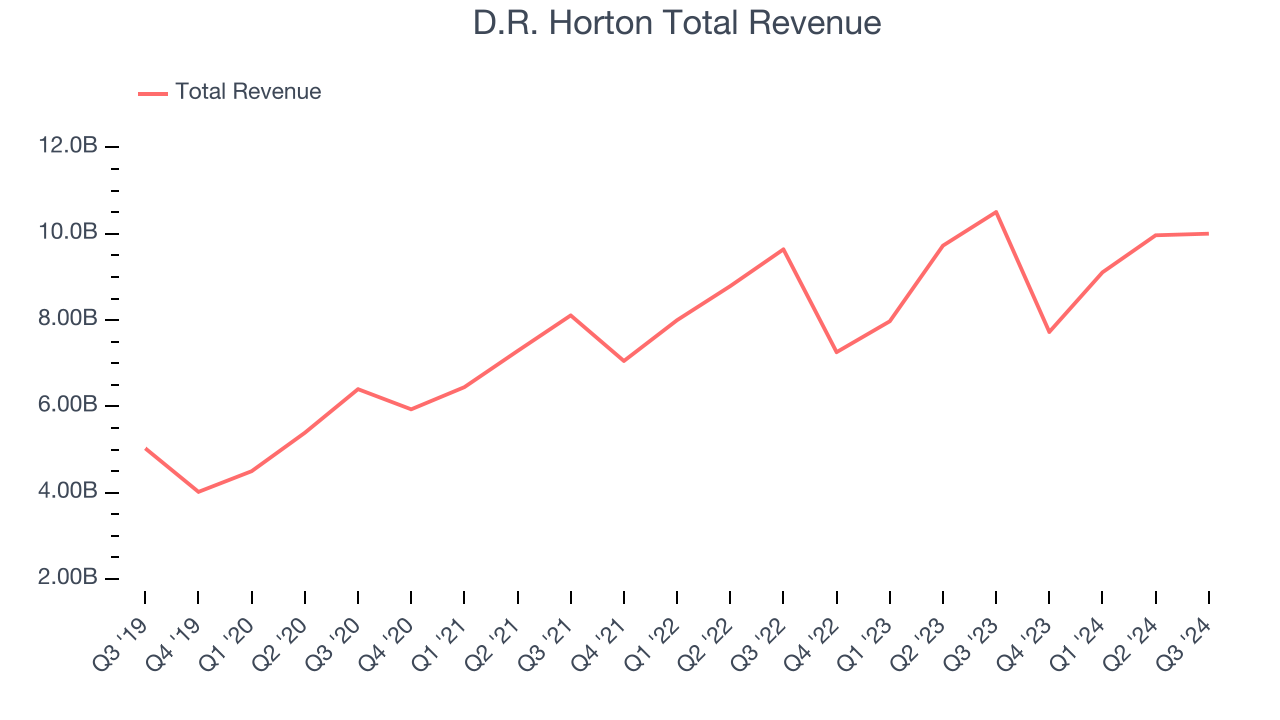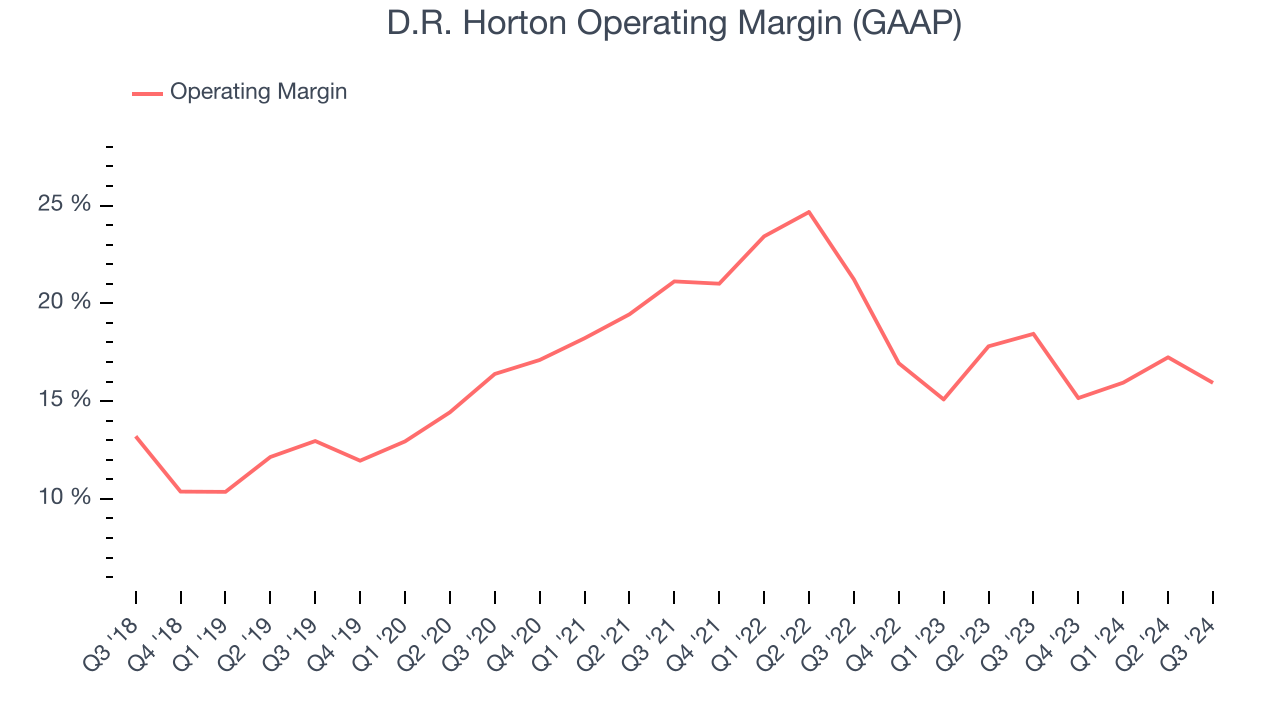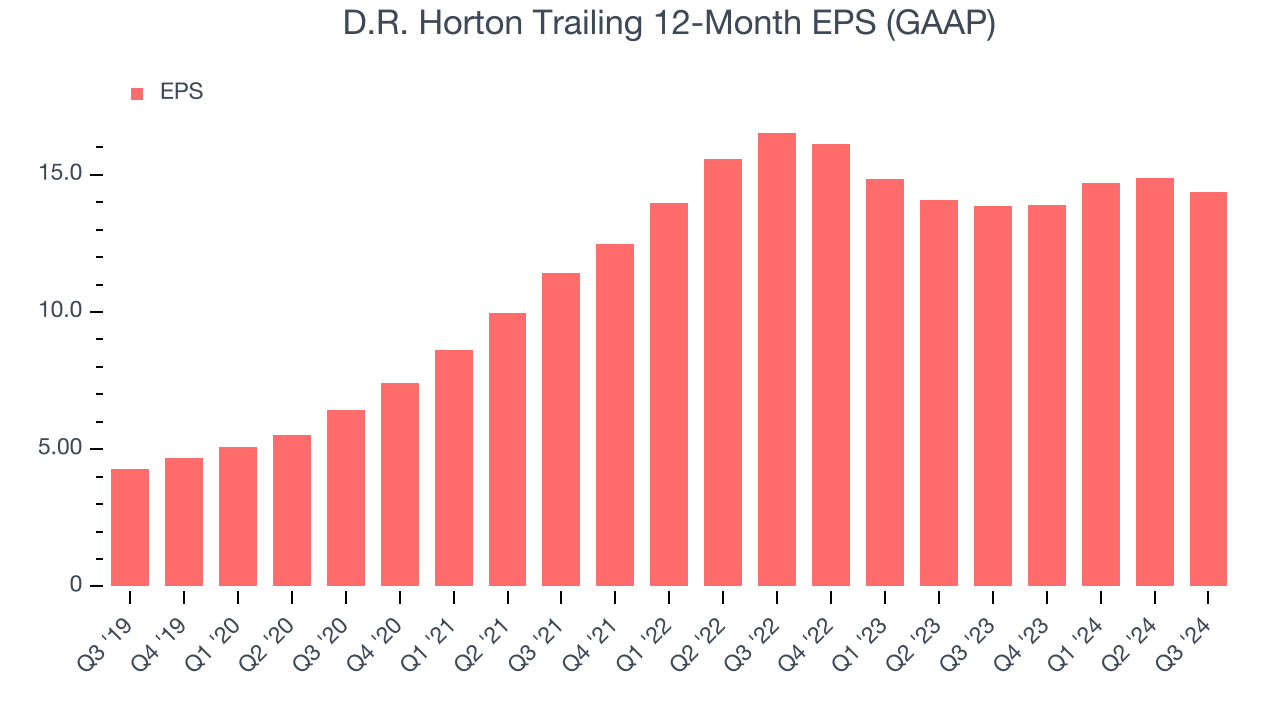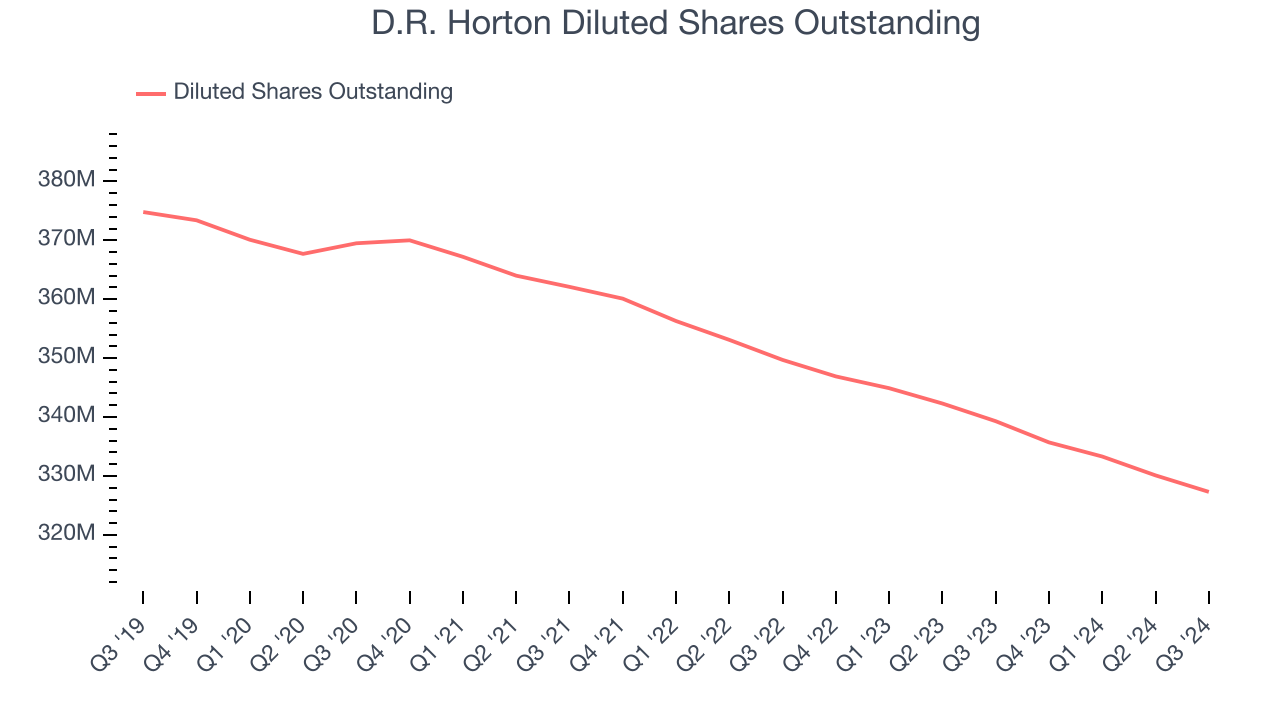Homebuilder (NYSE:DHI) missed Wall Street’s revenue expectations in Q3 CY2024, with sales falling 4.8% year on year to $10 billion. The company’s full-year revenue guidance of $36.75 billion at the midpoint also came in 7% below analysts’ estimates. Its GAAP profit of $3.92 per share was also 5.8% below analysts’ consensus estimates.
Is now the time to buy D.R. Horton? Find out by accessing our full research report, it’s free.
D.R. Horton (DHI) Q3 CY2024 Highlights:
- Revenue: $10 billion vs analyst estimates of $10.19 billion (1.9% miss)
- EPS: $3.92 vs analyst expectations of $4.16 (5.8% miss)
- EBITDA: $1.62 billion vs analyst estimates of $1.89 billion (14.4% miss)
- Management’s revenue guidance for the upcoming financial year 2025 is $36.75 billion at the midpoint, missing analyst estimates by 7% and implying -0.1% growth (vs 4.6% in FY2024)
- Gross Margin (GAAP): 25.5%, in line with the same quarter last year
- Operating Margin: 15.9%, down from 18.4% in the same quarter last year
- EBITDA Margin: 16.2%, down from 18.6% in the same quarter last year
- Free Cash Flow Margin: 19.3%, similar to the same quarter last year
- Backlog: $4.8 billion at quarter end, down 19% year on year
- Market Capitalization: $58.77 billion
David Auld, Executive Chairman, said, “The D.R. Horton team produced a solid fiscal 2024, highlighted by consolidated pre-tax income of $6.3 billion on $36.8 billion of revenues and a pre-tax profit margin of 17.1%. Earnings per diluted share in fiscal 2024 increased 4% to $14.34. Our consolidated cash flow from operations for fiscal 2024 was $2.2 billion, and we returned all of the cash we generated this year to shareholders through share repurchases and dividends. Over the past five years, we generated $9.0 billion of cash flow from operations, and we reduced our outstanding share count by 12%.
Company Overview
One of the largest homebuilding companies in the U.S., D.R. Horton (NYSE:DHI) builds a variety of new construction homes across multiple markets.
Home Builders
Traditionally, homebuilders have built competitive advantages with economies of scale that lead to advantaged purchasing and brand recognition among consumers. Aesthetic trends have always been important in the space, but more recently, energy efficiency and conservation are driving innovation. However, these companies are still at the whim of the macro, specifically interest rates that heavily impact new and existing home sales. In fact, homebuilders are one of the most cyclical subsectors within industrials.
Sales Growth
A company’s long-term performance can give signals about its business quality. Even a bad business can shine for one or two quarters, but a top-tier one grows for years. Thankfully, D.R. Horton’s 15.9% annualized revenue growth over the last five years was incredible. This is a useful starting point for our analysis.

We at StockStory place the most emphasis on long-term growth, but within industrials, a half-decade historical view may miss cycles, industry trends, or a company capitalizing on catalysts such as a new contract win or a successful product line. D.R. Horton’s recent history shows its demand slowed significantly as its annualized revenue growth of 4.8% over the last two years is well below its five-year trend. 
We can dig further into the company’s revenue dynamics by analyzing its backlog, or the value of its outstanding orders that have not yet been executed or delivered. D.R. Horton’s backlog reached $4.8 billion in the latest quarter and averaged 25% year-on-year declines over the last two years. Because this number is lower than its revenue growth, we can see the company hasn’t secured enough new orders to maintain its growth rate in the future. 
This quarter, D.R. Horton missed Wall Street’s estimates and reported a rather uninspiring 4.8% year-on-year revenue decline, generating $10 billion of revenue.
Looking ahead, sell-side analysts expect revenue to grow 7.1% over the next 12 months. Although this projection shows the market thinks its newer products and services will catalyze better performance, it is still below the sector average.
When a company has more cash than it knows what to do with, buying back its own shares can make a lot of sense–as long as the price is right. Luckily, we’ve found one, a low-priced stock that is gushing free cash flow AND buying back shares. Click here to claim your Special Free Report on a fallen angel growth story that is already recovering from a setback.
Operating Margin
Operating margin is an important measure of profitability as it shows the portion of revenue left after accounting for all core expenses–everything from the cost of goods sold to advertising and wages. It’s also useful for comparing profitability across companies with different levels of debt and tax rates because it excludes interest and taxes.
D.R. Horton has been a well-oiled machine over the last five years. It demonstrated elite profitability for an industrials business, boasting an average operating margin of 18.1%. This result was particularly impressive because of its low gross margin, which is mostly a factor of what it sells and takes huge shifts to move meaningfully. Companies have more control over their operating margins, and it’s a show of well-managed operations if they’re high when gross margins are low.
Looking at the trend in its profitability, D.R. Horton’s annual operating margin rose by 1.9 percentage points over the last five years, as its sales growth gave it operating leverage.

In Q3, D.R. Horton generated an operating profit margin of 15.9%, down 2.5 percentage points year on year. Since D.R. Horton’s operating margin decreased more than its gross margin, we can assume it was recently less efficient because expenses such as marketing, R&D, and administrative overhead increased.
Earnings Per Share
We track the long-term change in earnings per share (EPS) for the same reason as long-term revenue growth. Compared to revenue, however, EPS highlights whether a company’s growth was profitable.
D.R. Horton’s EPS grew at an astounding 27.3% compounded annual growth rate over the last five years, higher than its 15.9% annualized revenue growth. This tells us the company became more profitable as it expanded.

We can take a deeper look into D.R. Horton’s earnings quality to better understand the drivers of its performance. As we mentioned earlier, D.R. Horton’s operating margin declined this quarter but expanded by 1.9 percentage points over the last five years. Its share count also shrank by 12.7%, and these factors together are positive signs for shareholders because improving profitability and share buybacks turbocharge EPS growth relative to revenue growth. 
Like with revenue, we analyze EPS over a more recent period because it can give insight into an emerging theme or development for the business.
For D.R. Horton, its two-year annual EPS declines of 6.8% mark a reversal from its (seemingly) healthy five-year trend. We hope D.R. Horton can return to earnings growth in the future.In Q3, D.R. Horton reported EPS at $3.92, down from $4.45 in the same quarter last year. This print missed analysts’ estimates, but we care more about long-term EPS growth than short-term movements. Over the next 12 months, Wall Street expects D.R. Horton’s full-year EPS of $14.36 to grow by 11%.
Key Takeaways from D.R. Horton’s Q3 Results
We struggled to find many strong positives in these results. Its full-year revenue guidance missed and its EBITDA fell short of Wall Street’s estimates. Overall, this was a softer quarter. The stock traded down 7.8% to $166.26 immediately following the results.
D.R. Horton’s earnings report left more to be desired. Let’s look forward to see if this quarter has created an opportunity to buy the stock. We think that the latest quarter is only one piece of the longer-term business quality puzzle. Quality, when combined with valuation, can help determine if the stock is a buy. We cover that in our actionable full research report which you can read here, it’s free.
